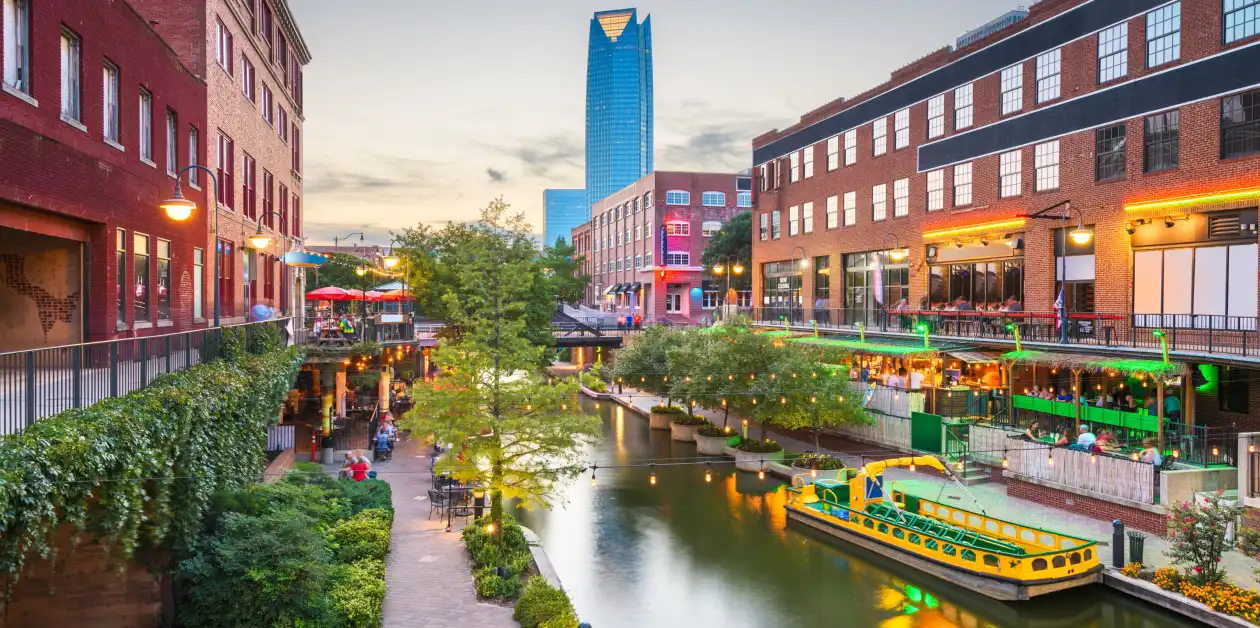Find Addiction Treatment in the Sooner State
Table of Contents
- Find Addiction Treatment in the Sooner State
- The Opioid Epidemic Hits Oklahoma Hard
- The Need for Drug Rehabs in Oklahoma: Addiction by the Numbers
- Addiction Treatment in Oklahoma: An Overview
- Oklahoma Alcohol and Drug Rehab Centers
- Inpatient Drug and Alcohol Rehabs in OK
- Dual Diagnosis Treatment in Oklahoma
- Oklahoma Drug Use Laws
- Addiction Treatment Legislation in Oklahoma
- How Much Does Rehab in Oklahoma Cost?
- Can I Use Insurance For Rehab In Oklahoma?
- Local Addiction Recovery Resources for Oklahoma
- Oklahoma State Drug and Alcohol Rehab Centers
- Benefits of Traveling for Addiction Treatment in Oklahoma
- Choosing an Effective Oklahoma Drug and Alcohol Rehab Center
- Why Would I Travel to Oklahoma for Rehab?
- Find the Best Oklahoma Rehab for You, Here!
According to the Oklahoma Department of Mental Health and Substance Addiction Services, Oklahoma has ascended to the number two rank in the US in recent years for the incidence of substance use disorders, with an estimated rate of 11.9 percent of state citizens suffering from this illness. The need for quality Oklahoma alcohol and drug rehab centers has never been more clear.
Over 43,000 inhabitants of Oklahoma County, where Oklahoma City is located, requested treatment for substance addiction in 2018; nevertheless, over 36,000 residents who required treatment for substance abuse went untreated.
Furthermore, more than 5,000 individuals were treated for drug abuse treatment in the county in 2018, with alcohol and methamphetamine addiction accounting for more than 54 percent of admissions combined. Despite this, prescription opioids were the leading cause of most fatal overdoses in Oklahoma County in 2017.
The Opioid Epidemic Hits Oklahoma Hard
The opioid epidemic has spread throughout the United States, causing many people to become addicted and seek treatment. According to the National Institute on Drug Abuse, opioids were implicated in 43 percent of drug overdose deaths in Oklahoma.
Oklahoma physicians prescribed roughly 79 opioids per 100 people in 2018. This is higher than the national average of 51.4 prescriptions per 100 people.
The Need for Drug Rehabs in Oklahoma: Addiction by the Numbers
- Unintentional poisonings, primarily from prescription drug overdoses, were the primary cause of accidental death in the state in 2009.
- Between 2004 and 2016, the number of prescription drug overdose deaths in Oklahoma more than doubled, while deaths from hydrocodone and oxycodone more than quadrupled.
- Binge alcohol consumption among 12 to 20-year-olds above the national average in 2012-2013. (15.4 percent vs. 14.7 percent ).
- Around 16,783 Oklahomans were enrolled in substance addiction treatment in 2015, an increase from 16,700 in 2013.
- In 2015, 3,500 Oklahomans received methadone treatment for opioid addiction, up from 3,090 in 2013.
- In 2015, 41% of Oklahomans sought treatment solely for a drug problem, 13% sought treatment primarily for alcoholism, and 45.2 percent sought treatment for both drugs and alcohol.
Addiction Treatment in Oklahoma: An Overview

Even though marijuana is the most often misused drug in Oklahoma, other substances also contribute to the state’s drug abuse statistics. According to a 2008 research, 4.85 percent of Oklahoma citizens reported using a substance other than marijuana in the previous month.
According to the same survey, the national average was 3.58 percent. Oklahoma has a higher-than-normal rate of drug-related deaths.
Many Oklahomans seek treatment for a range of substance abuse issues, however, the bulk of inhabitants rely on the medications listed below:
Methamphetamine is currently one of Oklahoma’s most serious drug-related issues. According to state law enforcement officials, makeshift “one-pot” meth labs are especially prevalent in rural areas of Oklahoma.
Drug trafficking organizations (DTOs) from Mexico and the United States’ southwestern states, such as Arizona and New Mexico, are also sources of meth in the state.
Prescription drug misuse is one of Oklahoma’s fastest-growing issues. Between 2007 and 2011, over 3,200 unintentional overdose deaths occurred, with 81 percent using at least one form of prescription drug.
Opioid medications such as oxycodone, alprazolam, and hydrocodone are currently responsible for the majority of overdose deaths. In 2011, hydrocodone caused more fatal overdoses than meth, heroin, and cocaine combined.
Oklahoma is one of many states in the United States dealing with a drug epidemic. Combating a substance addiction, on the other hand, can be a battle in and of itself. Those addicted, and their loved ones may feel hopeless because they are unable to break the pattern of abuse.
Oklahoma Alcohol and Drug Rehab Centers
The great majority of people require long-term therapy to recover from addiction and substance use disorder (SUD).
Because therapy is not one-size-fits-all, Oklahoma drug and alcohol rehab centers provide a wide range of drug and alcohol addiction treatment programs, which are broadly classified as an inpatient (also known as residential treatment and may include hospital care) and outpatient.
Inpatient Drug and Alcohol Rehabs in OK
Inpatient rehabilitation programs are often known as residential treatment. You must enter a supervised setting to overcome your addictions. You will be obliged to live in the facility and get medical and emotional support 24 hours a day, seven days a week. This program is designed for people who have moderate to severe addictions.
Outpatient Rehabilitation and Treatment
Because it exposes clients to triggers, outpatient treatment is suitable for those with moderate to severe addiction. You will not be residing at the facility during these sessions, as you would during inpatient treatment. Instead, you will live at home and travel to treatment sessions regularly. An outpatient program will require a minimum of 10 to 12 hours per week.
Programs for Partial Hospitalization (PHPs in Oklahoma)
People who have previously received inpatient care typically choose PHPs as a “step-down” option. It is also an option for early intervention for certain people before their symptoms or behavior necessitate inpatient care.
PHP programming can take up to 12 hours per day, five days per week, but you can do it from home. During the first 1-2 days in a PHP, clients are frequently visited by a physician, but a nurse is always there.
Collaboration with the entire care team is required for PHPs. Behavioral and holistic therapies, wellness education, leisure activities, family and group meetings, and medication may all be part of your treatment.
Intensive Outpatient Treatment Programs (IOPs in Oklahoma)
Intensive outpatient programs (IOPs) provide a higher level of care than typical outpatient programs. These programs allow you to spend more time away from drugs or alcohol, as well as the people who may cause you to relapse. Regardless, IOP is still an outpatient treatment. It has fewer restrictions than residential treatment.
IOP allows you to keep your family and professional obligations while spending more time in therapy. This is the greatest alternative if you find it difficult to leave your life behind for a lengthy period.
Medical Detox for Oklahoma Residents
Inpatient treatment usually begins with detoxification under medical supervision. Physicians and addiction specialists will examine your vital signs as the opioids exit your system during medical detox. Drug cravings are frequent and difficult to conquer during detox. As a result, medical detox is recommended to avoid relapse.
Although the continuous medical care offered during medical detox helps in preventing recurrence, doctors can also administer the necessary medication and medical understanding to reduce cravings and withdrawal symptoms.
Withdrawal happens when the brain reacts to the substances in the brain. Withdrawal symptoms can be lethal in extreme cases. This means that opiates, benzodiazepines, alcohol, and heroin should never be stopped without consulting a doctor first.
Dual Diagnosis Treatment in Oklahoma

Substance misuse and mental disorders are inextricably linked. Co-occurring illnesses occur when a person has both a mental illness and a substance addiction condition. In this scenario, dual diagnosis is used.
More than half of persons diagnosed with substance misuse will also suffer from a mental disease at some point in their lives. Therapy for a dual diagnosis is required by 32% of Oklahomans in drug misuse treatment.
Dual diagnosis treatment is the most effective treatment option if you have co-occurring disorders. It should address both your mental health problems and your substance misuse problem. Oklahoma has dual diagnosis treatment facilities, and many of them provide financial aid, such as sliding scale pricing.
After-Care Assistance
The completion of an addiction treatment program is only the beginning of a continual recovery journey. The most effective addiction treatment facilities provide long-term aftercare services that may include:
- Sober-living homes
- Participation in 12-step programs and support groups
- Community services and educational opportunities are available.
- Vocational services
- Group therapy
Oklahoma Drug Use Laws

Oklahoma has some of the most strict drug regulations in the country. Every year, around 17,000 people are arrested in Oklahoma for drug-related charges such as possession, sale, or manufacturing of any illegal narcotic. Oklahoma has draconian drug punishments, which can include high fines, lengthy jail terms, or a combination of the two.
Oklahoma has five controlled substance schedules: I, II, III, IV, and V. Substances in Schedules I and II have the highest potential for misuse and no accepted medicinal value. Substances in categories III through V, on the other hand, comprise medications with a lesser risk of dependence and more use in medical contexts.
While each schedule has a large number of compounds, the following are some of the most often used medications in each:
- Schedule I includes Heroin
- Cocaine, morphine, and methamphetamine are all classified as Schedule II drugs.
- Anabolic steroids are classified as Schedule III.
- Klonopin and Ativan are both on Schedule IV.
- Medication in Schedule V contains precise quantities of codeine, opium, pseudoephedrine, and other substances.
Addiction Treatment Legislation in Oklahoma
Educating the public about the harm that drugs cause to communities is a critical first step toward resolving Oklahoma’s myriad drug usage problems. Oklahoma has made significant progress in minimizing the deadly impacts of drug use through action-oriented efforts.
The state launched a comprehensive plan to tackle drug abuse in 2013. Among the several strategies:
- Collaborating with local media and news organizations to address the issue of drug overdoses
- Townhall meetings are intended to educate communities and school groups.
- Implementing practices in hospital emergency rooms and clinics to dissuade patients from seeking medical attention (visiting doctor after doctor to get more drug prescriptions).
- Advocating for the expansion of community-based substance misuse treatment and recovery services.
A community’s approach to a substance misuse problem cannot be “set and forget.” To maintain the safety and well-being of all parties concerned, it is necessary to constantly try to raise awareness and educate communities.
Methamphetamine Offender Registration Act of Oklahoma
Oklahoma towns are dealing with the negative consequences of a huge methamphetamine epidemic. One-time offenders who believe they can continue to possess, manufacture, and distribute methamphetamine are substantially to blame for the drug’s widespread use.
The Oklahoma Methamphetamine Offender Registration Act is intended to track meth offenders and prevent recidivism.
A person convicted of a meth-related felony in Oklahoma is required to register as a meth offender and is forbidden from obtaining or possessing pseudoephedrine. Pseudoephedrine, a nonprescription decongestant, is a key element in the production of meth.
Before the enactment of legislation limiting the amount of medicine that may be purchased, Oklahoma had a pseudoephedrine monitoring system in place. The daily purchase restriction for pseudoephedrine is 3.6 grams, with a monthly maximum of 7.2 grams, according to state law.
Oklahoma seeks to diminish the presence of meth in its communities, as well as cases of misuse and addiction, by restricting access to the legal pharmaceuticals used to produce meth, as well as the people who can obtain them.
The “Safe Trips for Scripts” Program in Oklahoma
After treating a medical problem, it is typical to have leftover pill prescriptions. Many people simply store extra pills in the medical cabinet since they are confused about how to dispose of them. Others, on the other hand, can readily locate the pills and consume, sell, or swap them.
Oklahoma has created a prescription drop-off box plan to prevent prescription pharmaceuticals from being abused or sold on the illicit market. The boxes, which are part of the state’s “Safe Trips for Scripts” policy, serve as permanent drop-off locations for people to securely dispose of unneeded prescription prescriptions.
Prescription drop-off boxes, such as those in Oklahoma, have been shown to drastically reduce the number of unneeded prescriptions on the street.
Expired cold drugs and over-the-counter pain remedies are permitted in addition to prescription medications. The drop-off boxes in Oklahoma do not accept liquid drugs, needles, glass goods, or inhalers.
How Much Does Rehab in Oklahoma Cost?

Many people looking for Oklahoma drug and alcohol rehab centers are concerned about the expense, which can be a deterrent to treatment. Fortunately, there are numerous methods to obtain financial support for drug and alcohol treatment, providing Oklahoma citizens with a range of viable options.
Some people may discover that their private health insurance will cover the cost of rehabilitation. Furthermore, government-funded insurance programs like Medicare and Medicaid may help with expenditures. Another alternative for paying rehabilitation fees is an installment plan. This payment type is only accepted at a few facilities in the state.
The cost of rehabilitation in Oklahoma varies according to the level of treatment provided. Factors such as inpatient or outpatient treatment settings, medication-assisted therapy, and program facilities all have an impact on the overall cost of the program.
Can I Use Insurance For Rehab In Oklahoma?
The majority of Oklahoma drug and alcohol rehab centers accept private health insurance to pay treatment costs. Many facilities accept Medicaid and Medicare as well.
To find out if you can use your BCBS of OK insurance policy to help pay for rehabilitation treatments, simply call the recovery representatives at Find Addiction Rehabs now, for a quick and confidential breakdown of costs and coverage.
Getting Treatment in Oklahoma Without Insurance Coverage
Many people with SUD do not have health insurance. In reality, 37.3 percent of those who attempted but did not receive counseling could not afford it.
Fortunately, some Oklahoma financial institutions have decided to make medical bill loans available. One of the approved organizations that provide financial support is the National Health Service Corps. However, the specific amount borrowed will be determined by your credit score.
Are Free Alcohol and Drug Rehabs Available in Oklahoma?
For people who cannot afford treatment, Oklahoma has 127 free alcohol and drug addiction treatment clinics. FindTreatment.gov will assist you in locating some of these treatment facilities.
This is one of the top websites for finding answers to concerns like “Where can I find free alcohol and drug rehabs near me?” It offers a directory of free drug rehab clinics in Oklahoma and other states.
Local Addiction Recovery Resources for Oklahoma
- The Department of Mental Health and Substance Abuse Services in Oklahoma (ODMHSAS). The ODMHSAS offers treatment solutions as well as a list of resources/providers to those suffering from mental diseases and drug addiction.
- Oklahoma’s chapter of the National Alliance on Mental Illness (NAMI). NAMI Oklahoma assists people with mental illnesses and their families in obtaining services, resources, and support groups.
- Alcoholics Anonymous Oklahoma Chapter. This is the official website for Oklahoma Alcoholics Anonymous (AA) meetings. It contains the dates and locations of all AA meetings in the state.
- Oklahoma Narcotics Anonymous. This is the official website for Oklahoma Narcotics Anonymous (NA) meetings. It, like the Oklahoma AA website, lists the locations and times of NA meetings around the state.
Oklahoma State Drug and Alcohol Rehab Centers
The Support for Treatment and Recovery Services (STARS) Division of the Oklahoma Department of Human Services is in charge of ensuring the excellence and efficiency of substance abuse treatment programs across the state. The division promotes a “healing is possible” approach to addiction treatment and offers tailored programs in each of Oklahoma’s towns, including programs for women and children, juveniles, and persons who have previously been incarcerated.
Every person who checks into an Oklahoma drug and alcohol rehab center undergoes a thorough evaluation, which aids in the development of tailored recovery strategies for each patient. Medical detoxification, inpatient residential treatment, outpatient counseling, substance abuse education, transitional halfway housing, and aftercare recovery support are some of the treatment and therapy alternatives.
After deciding to seek treatment for an addiction, the next step is to determine where you wish to get treatment.
Benefits of Traveling for Addiction Treatment in Oklahoma
 When it comes to drug or alcohol rehab sometimes going to a new city or state is the best option. This can provide different treatment options that you may not otherwise be able to find where you are from. There are thousands of treatment centers across the United States, and Oklahoma is home to many great ones.
When it comes to drug or alcohol rehab sometimes going to a new city or state is the best option. This can provide different treatment options that you may not otherwise be able to find where you are from. There are thousands of treatment centers across the United States, and Oklahoma is home to many great ones.
Benefits of traveling for rehab include:
- Puts you in a new mindset of taking a journey toward recovery
- Allows you to have a fresh start
- Puts distance between yourself and your triggers
- Reduces the desire to use drugs or alcohol
- Reinforces your commitment to sobriety
- Prevents you from leaving treatment early
- Allows you to live somewhere you may have never been
- Keeps your recovery private
Choosing an Effective Oklahoma Drug and Alcohol Rehab Center
In Oklahoma, there are numerous facilities dedicated to the treatment of substance misuse; however, not all of these facilities provide the same recovery programs, levels of care, or therapeutic modalities.
When choosing the best rehabilitation center for yourself or a loved one, it is critical to consider the numerous factors that have the potential to influence the quality of care received and the level of success obtained.
Here are a few examples:
- Whether or if the institution accepts either your insurance company or Medicaid
- If the treatment facility provides payment plans or tuition help
- If the facility offers detoxification or MAT programs, are they medically supervised?
- How long do you stay in various forms of therapy, and how long will the activities at the rehabilitation center last?
An effective rehabilitation program includes treatment for mental health disorders in addition to substance abuse.
What do Oklahoma Drug Rehab Programs Not Provide?
When examining drug treatment programs in Oklahoma, it is critical to consider whether living close to one’s home will be useful or detrimental to one’s rehabilitation. At first look, this may appear to be an uncommon remark.
After all, if you went into a nearby drug recovery program, you’d be able to leave treatment each day and return home anytime you wanted. Furthermore, you are close to your friends and family, making it easy to acquire the aid you require.
These ostensibly beneficial characteristics, on the other hand, may lead you back to your addiction. For example, if you return home every night, you will be presented with the same living room where you used drugs the night before. Furthermore, staff members have a lower level of accountability to you. Moreover, if members of your social circle or family are drug users, they may encourage you to take drugs for yourself, which may lead to a relapse.
Getting sober does not imply that you will never return to your previous life or see the people who care about you again. However, before succumbing to these temptations, make sure you can resist them.
Why Would I Travel to Oklahoma for Rehab?

Some people believe that the only way to overcome an addiction is to seek treatment in a facility in another state or even a different section of the country. It has been shown that patients heal faster when they can travel to their therapies. When you are physically isolated from the things that produced your addiction, it is much simpler to stop engaging in dangerous behaviors and triggers.
One of the advantages of Oklahoma’s drug and alcohol rehab centers is that they provide comprehensive treatment programs to addicts on the road to recovery. Drug rehabilitation clinics in Oklahoma provide several treatment alternatives, including 12-step recovery programs, a treatment that does not require the 12-steps, and holistic treatment.
After they have completed the detoxification procedure, the vast majority of treatment centers aid clients not only in withdrawing from drugs but also in their mental and emotional recovery. Substance abuse problems can be emotionally exhausting, and relapse is likely if those issues are not addressed throughout therapy. Counseling may also be good for family members to provide a solid support system for the healing client.
Find the Best Oklahoma Rehab for You, Here!
It is not enough to simply analyze the location to decide where to go for rehab; the program has to be a good fit for your needs and affordable as well.
Find Addiction Rehabs has made this possibility available to you. Please contact our recovery representatives as soon as possible so that we help you find a good treatment match for you or your loved one, quickly and confidentially.

